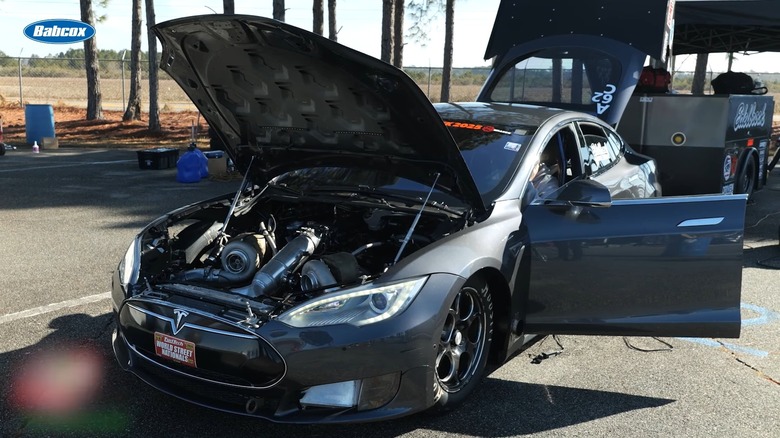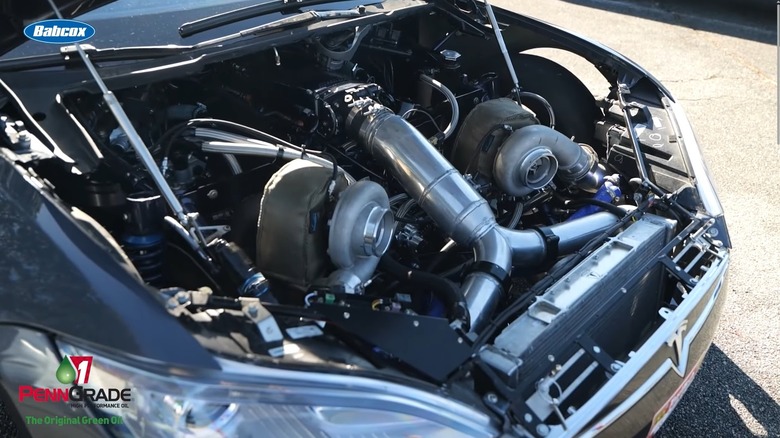This Tesla Isn't Electric - It's Powered By A Chevy Big Block
Typically, Teslas produce almost no noise at startup due to their EV powertrain. They're primarily designed for comfort and range, with the typical Model S capable of about 400 miles without a recharge. But this Model S is anything but "typical," as is immediately evident when you look under the hood. Rather than sporting the EV powertrain one would expect, this particular car boasts an absolute beast of a big block: a 565 cubic-inch twin-turbo Chevy-pattern V8. Introducing Robert Freund's 1,700-horsepower monstrous creation that's almost certainly sacrilege to a few purists out there, a drag racer that, according to Robert, is actually still perfectly capable of street-driving as well. Just imagine seeing this thing at a traffic light.
Robert's build, by necessity, runs far deeper than just slotting a big block into the front end of a Model S. All Tesla models are EVs, and have always been since day-one; as such, a Model S was never designed to accept an internal combustion engine. Making one work in such a car required extensive chassis fabrication. According to Freund in a video detailing his build, "The car's really wide so we couldn't use any of the typical chassis measurements... It started out as a chassis-in-a-box kind of deal." As the car was fabricated and began to take shape, he explained that it went from being a dedicated dragster to a roadgoing drag and drive car, and is apparently a dream to drive both on and off the track. And that's not mentioning the bonus points of revving a big block from an otherwise unassuming car, likely scaring other racers half to death in the process. Let's take a look under the hood and see the magic up close.
The project's inception and powerplant specs
Like many great concepts, Robert Freund's beast was born from a few beers, a wrecked car, and a dream. He originally picked up a damaged Model S with the intent to reuse the electric motors in a buddy's '68 Mustang project, but the project fell through and stalled, leaving Freund with a car with no apparent purpose. That all changed with the frankly brilliant idea to shove the largest engine physically possible into the front end, in this case a 565 cubic-inch Chevy with twin turbos — and turbos can be just as good as superchargers for drag racing. They're not the largest on the block, by any means; bigger turbos can easily push over 2,000 horses from this displacement with no issues. First popularized back in November 2024, the big block Model S remains one of the more understated but surprising dragsters in the past year.
The heart of this build rests in that 565 V8. The block itself comes from Dart Machinery, known for producing high-power capable GM-style big block V8 lowers. Several components sport Edelbrock-brand logos, such as the Comp Cams EVO crankshaft, hydraulic lifters, and roller cam; Freund works at Edelbrock, which owns Comp Cams. Currently, he and his team lack a turbo sponsor, so they're running a relatively modest setup. He didn't remember what specific turbos they are, just that they're about 62 to 64-millimeter diameter and running about 20 PSI of boost. The turbos are too small for the engine's displacement, so they run out of the power band too soon and curtail the engine's true capabilities, according to Freund.
The rest of Robert's build
Obviously with the electric motors removed, Freund's team had to radically alter the Tesla's drivetrain. To handle all this beef, the car sports an FTI TH400 automatic transmission, the largest of which is designed to handle upwards of 2,000 horsepower. And to help lower the overall profile, the team designed a custom dry-sump oil system, allowing the engine to be set further down to provide adequate clearance and lower the center of gravity. It likely has a plethora of custom parts throughout the running gear to go with it, thanks to the level of chassis fabrication. All this culminates in what he expects to be quarter-mile times in the 8.5-second ballpark. Interestingly, the NHRA actually banned the Tesla Model S Plaid; this offers a clever alternative to get around that rule.
The fact that it's street-capable on top of everything else is just as impressive; after all, it's often difficult to build a car that reportedly handles well on public roads while having well over 1,000 horsepower and a fabricated chassis. It's not precisely a sleeper, as it's evident that there's something going on even with the hood closed. But it'll certainly turn heads and produce startling pass times all the same.
The build is a result of a collaborative effort between Freund, Edelbrock, AFCO, and a team of fabricators and friends. And according to him, even EV purists apparently dig the build so far, though it's likely far from 100% completion. That said, it'd be a real treat to see exactly how fast it can go with the right sponsor and setup.


